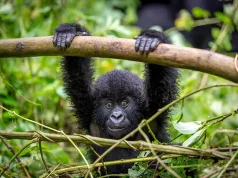For decades, lions in the North-Eastern Central African Republic have been on the brink, their numbers diminished by persecution, poaching, and insecurity. Since 2019, monitoring by the Wildlife Conservation Society (WCS) had revealed only males, raising fears that breeding females—and with them, the possibility of a population recovery—had vanished from the region.
Today, that fear has given way to hope. WCS has captured the first photographic and video evidence (link to photos and video) not only of a lioness, but three cubs, in Bamingui-Bangoran National Park. This landmark discovery is the clearest sign yet that lions are starting to reclaim their place in this critical landscape.
“This is the payoff of years of relentless protection and patience,” said Armand Luh Mfone, WCS’s Director of Programs for CAR. “The CAR government, WCS and partners have worked hard to secure this landscape against poaching and conflict. To see not just a lioness, but a mother raising cubs, gives hope that the ecosystem is healing.”
On August, 7, 2025, WCS issued a news release with a photo of a lactating lioness: Signs of Lion Recovery: WCS Camera Trap Captures First Lioness in Northern CAR since 2019. The field team then launched a major effort to saturate the area with silent infra-red video cameras.
“We combined satellite imagery with on-the ground field knowledge and an understanding of lion behavior to target high value real estate for a mother lion—rocky outcrops, forest corridors near savanna patches and water sources,” said John Guernier, WCS’s Director of Bamingui-Bangoran National Park. “We set cameras on roads and trails leading to these spots; we avoided the possible den-sites themselves so we didn’t disturb the cubs, and we just had to hope that she would lead cubs past our cameras. After weeks of waiting, our plan finally paid off.”
The photos and video issued today show the lioness first photographed in April has three cubs, estimated to be about 4-months old.
Since WCS began intensive monitoring in 2019, all evidence pointed to an imbalanced population: only males were recorded. The absence of females cast doubt on whether the species could truly rebound here. Now, the appearance of a nursing lioness and cubs signals active reproduction—proof that NCAR’s lions are not only surviving but breeding again.
The discovery marks a milestone in conservation for a population estimated to number only a few dozen individuals at best. The next six months will be critical for the survival of these cubs, as natural threats such as disease, predation, and separation remain high during their first year of life. Unlike lions that live in prides, this mother must protect her young entirely on her own. To support her, we are intensifying patrols within the Intensive Protection Zone and conducting surveys to detect snares. While no area is free from risk, WCS is ensuring this site receives heightened protection, particularly during the transhumance season.
“Lions have been hammered for years in northern CAR, but the three cubs show what’s possible when habitats remain intact and conservation is persistent,” saidLuke Hunter, Executive Director of WCS’s Big Cats Program. “Where there is one lioness, there are almost certain to be more; and now that we know there is at least one litter, I’m sure that others will follow. With our partners and the CAR government, we are determined to give these cubs as great a chance as possible to live as wild lions, free of persecution. If we succeed, many years from now the descendants of these cubs will be part of a thriving, protected population many hundreds strong.”
WCS extends appreciation to Arcadia, Ayers Wild Cat Conservation Trust, the European Union, Fondation Segré, The Rob Walton Foundation, and Wildlife Conservation Network’s Lion Recovery Fund for their steadfast support of conservation in the Central African Republic.





